The military career of Albrecht Christoph Quast lastet 39 years. It took place during the Thirty Years War (1618-1648) and continued until 1669. Let me be clear: I am not trying to heroize warfare or weapons or anything. Rather, this description solely aims at better positioning Quast’s life within the circumstances of his era.
The Thirty Years War was a conflict for hegemony in the Holy Roman Empire of the German Nation (962-1806) as well as in Europe, and it was also a religious war. On the Empire-level the war erupted between the Holy Roman Emperor and the Catholic League on the one hand and the Protestant Union on the other. On the European level it erupted from the contrast of Habsburg and France. Together with their respective allies, the Habsburg powers of Austria and Spain fought their dynastic conflicts against France, the Netherlands, Denmark and Sweden. As a result, a number of other conflicts are associated with the Thirty Years’ War: the Eighty Years’ War (1568-1648) between the Netherlands and Spain, the French-Spanish War (1635-1659) and the Torstenson War (1643-1645) between Sweden and Denmark.
The war ended on October 24, 1648. The campaigns and battles had taken place mainly within the area of the Holy Roman Empire of the German Nation. The war itself, and in addition famines and epidemics devastated and depopulated entire regions. In some parts of southern Germany only a third of the population survived. After the economic and social devastation, some war-affected territories needed more than a century to recover from the consequences.
Introduction
Around 1500 a phase of intensive renewal in warfare began. The increasing importance of firearms transformed the art of siege warfare (poliorcetics) and the training of soldiers. Sailing-ships with cannons provided the Europeans a hitherto unknown naval supremacy.
Although worldwide developments differed, certain trends can be identified. Japanese commanders of the 16th century recognized that a well disciplined peasant infantry equipped with firearms were able to stand their ground against the mounted elite of the Samurai. The infantry in Europe, armed with muskets, were subjected to a similar taut drill. They learned to shoot in volleys and to maintain formation on the battlefield. The massed use of pikemen was standard in Europe: European military theorists concerned themselves with the suitable combination of muskets and pikes for about 150 years, until – at the end of the 17th century – the bayonet emerged.
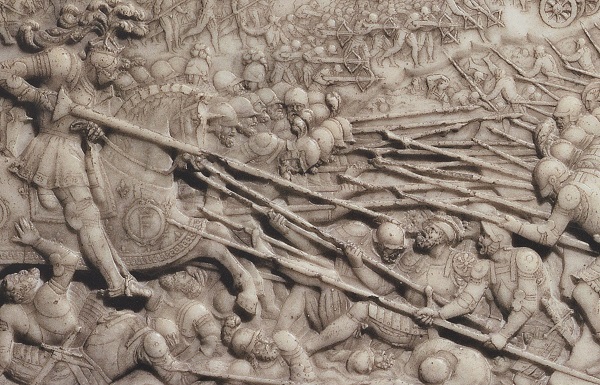
Battle of Marignano: This depiction of his victory at Marignano in 1515 adorns the grave of Francis I (François Ier) of France. During an attack with his lance he led his knights against Swiss pikemen and field artillery.
The conquest of the Aztec and the Inca Empires by small Spanish forces in the 1530s and 1520s was atypical for the European military. The most effective army of the 16th century was that of the Ottoman Empire. The largest wars of the 17th century were led by the Manchus in China, in Europe the unceasing religious and dynastic conflicts expedited technological development.
The armored knight became the cavalryman armed with pistol and sword. Fortifications were adjusted to the threat by cannons and thereby became more sophisticated. Concurrently, similar adjustments took place in the equipment used in the art of siege warfare (poliorcetics). While in the Mediterranean Sea still rowing galleys crossed, in the Atlantic sailing-ships developed into imposing weapons platforms: A single ship had as many cannons as a whole land army. Standing armies – drilled, disciplined and uniformed – eventually replaced the earlier European traditions of mercenaries, henchmen, conscripts and militia. The increasingly centralized states of Europe with their wealth maintained an expanding military.

Bidenhänder. Date 1550. Origin Germany. Weight 3.18 kg. Length 140 cm. Such swords were carried in Germany mainly by the soldiers defending the company flag. They were carried over the shoulder. In order to “shorten” the handle in close combat, the blade was grabbed at the ricasso, the hooks protected the hand.
Pikes and Muskets
In the 16th and 17th centuries Europe was almost constantly in the state of war. In the course of these numerous conflicts European armies experimented with battle techniques, which imparted new significance to an infantry equipped with pikes and firearms.
Foot soldiers in medieval Europe were often effective, but generally had little prestige. In the early 16th century, however, the Renaissance rediscovered military techniques of antiquity – the Greek phalanx and the Roman Legion suddenly made infantry fashionable again. The most admired fighters in Europe in the 16th century, such as the German Landsknechte and the Spaniards in their Tercios, fought on foot in massed bunchs of pikemen. This formation had been developed by the Swiss, but now firearms were added: Although some foot soldiers continued to use the bow, during in the Italian Wars (1494-1559) the matchlock arquebus excelled as the most important long-range weapon. It was neither accurate nor powerful, but could weaken a hostile pike square or repel a cavalry charge. In addition, mobile field artillery made of bronze now appeared, firing iron shots.

Halberd, around 1500, Germany. Weight 2 kg. Length 41.2cm (head). The halberd was versatile: The blade was used to cut, the tip for thrusting and the hook on the back to pull riders off their horse. The languets protected the shaft from damage.

Landsknecht sword. Date around 1550. Origin Germany. Weight 1.54 kg. Length 96 cm. Typical for these swords widespread among the infantry in Germany and northern Italy were the eight-shaped quillons. This specimen actually already has a hilt close to a swept hilt.

Landsknecht dagger. Date around 1520. Origin Germany. Weight 330 g. Length 31cm. This simple weapon was widespread in Europe and indispensable in close combat. Most had a double-edged blade with a flat, diamond-shaped cross-section. Over the course of the century, the blade became narrower.
Discipline of the Infantry
If they could afford it, the infantry of the 16th century wore extensive plate armor as protection against arquebus bullets, pikes, swords, and halberds. Since the second half of the 16th century, however, the matchlock musket gradually spread: a heavier weapon that needed a support for aiming, but could penetrate most armor plates at an intermediate distance. The importance of discipline for the effectiveness of the infantry was already evident with the peak square: A soldier with a 5.5 m long pike was excellent as part of a dense formation, but all alone he was useless. But with the increased use of firearms the drill also had to be further refined: loading and firing was a complex process, especially in massed troops operations, and therefore could only be performed correctly in battle formation by strict discipline. In the 17th century, troops armed with muskets formed next to the pike squares and fired in volleys – either together for of the shock effects, or in succession to maintain continuous fire.
Much faster than field battles European siege warfare (poliorcetics) was shaped by powder artillery. The high stone castle walls decrepit around 1500 were gradually replaced by star-shaped fortresses during the Italian Wars, which not only withstood the fire of cannon, but also allowed defenders the optimal use of cannon and firearms. Therefore, sieges became even more lengthy and costly, and the besieging infantry had to spend months in trenches for protection against the defenders’ firepower.

Matchlock musket, Britain, around 1650. Weight 6,05 kg. Barrel length 126 cm. Caliber 19 mm.
Artillery as an effective weapon became a standard in the early 16th century. As a result, a number of different types arose, including field artillery and light “pieces” for the use at sea. Through improvements in casting technique now stronger cannons made of bronze were cast instead of the previous pipes made from composite iron rods, and with the introduction of the better granular gunpowder at the end of the 16th century, cannons with longer range and shorter tube could be build. In the Thirty Years’ War (1618-1648) and the English Civil War (1642-1651) artillery became firmly established, and cannons integrated into infantry regiments.
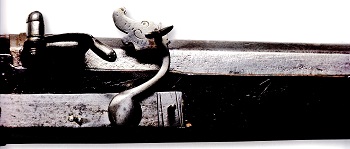
Detail of matchlock musket, Britain, around 1650. Weight 6,05 kg. Barrel length 126 cm. Caliber 19 mm.
Armor and Weapons of the European Infantry
Prior to the 16th century, during peacetime standing armies barely existed. Professional soldiers belonged either to the bodyguard or provided garrison duty. In wartime, recruits were assembled and mercenaries hired. In the early 16th century permanent infantry units such as the Spanish Tercios were established, drilled them in tactical maneuvers and trained them in effectively dealing with their weapons. Such troops and the increasingly available small firearms questioned the supremacy of the fully armored knight. Manufactories in Italy, Germany and the Netherlands produced more swords, polearms, small firearms and armors and sent them to the new units throughout Europe.
The Matchlock Musket – Simple but Effective
The invention of the Hakenbüchse, from which the French term arquebus is a malapropism, with a matchlock is not precisely datable, but most probably took place around 1475 in Germany. From this, the arquebus and the musket emerged. A saltpeter soaked cord served as a igniter. This smoldering fuse, attached in swivel bracket, by pulling the trigger was pressed on a a small amount of gunpowder in the flash pan, which through the touch hole inflamed the propellant charge in the muzzle. At the beginning of the 17th century flintlock mechanism began to supersede the matchlock, which however were still in use at the end of the century due to their simplicity and low cost.
The Battle of the White Mountain (Bílá hora)
In the Thirty Years War all armies used pikes and matchlock muskets. An example of this battle method is the Battle of White Mountain, a major collision during the early stages of the conflict.
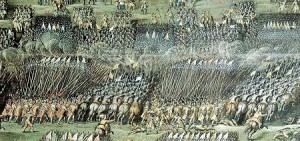
The Battle of the White Mountain (Bílá hora). Pike squads amidst thick smoke over the central battlefield, testifying the use of black powder cannons and guns.
The Battle of the White Mountain was fought on November 8, 1620 at Prague. 13.000 rebellious Bohemian Protestants encountered the combined 39,950 troops of the Emperor of the Holy Roman Empire and the Catholic League. Under Christian of Anhalt, the Protestants had taken a favorable defensive position on the hill, but the Catholics under Johann Graf von Tilly were more experienced and had great fighting spirit.
Pike square (Gevierthaufen, Gewalthaufen)
On both sides of the pikemen formed dense groups, as was common in European warfare since more than a hundred years. The smaller part of the infantry, equipped firearms and especially matchlock muskets, took position as a “hedge” around the pike square or as “wings” at its four corners. Influenced by new tactical developments from the Netherlands, the Protestants organized their piles more flat, that is, fewer rows deep than the Catholic. Just like the infantry, the cavalry was deployed in dense formations. Each cavalryman carried several wheellock pistols, which he already loaded for battle. The horsemen were less comprehensive armored than the medieval knight, but the steel plates offered some protection, even against musket bullets.
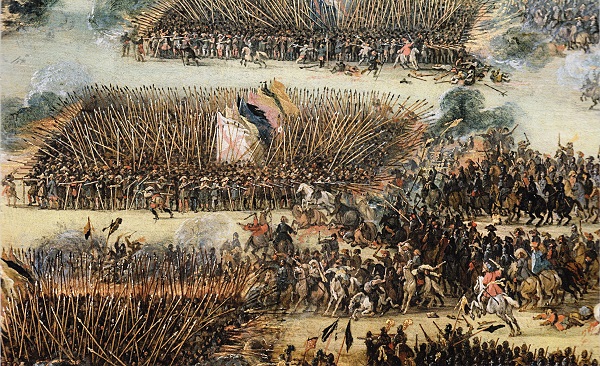
Spanish Tercios: In the Eighty Years’ War (Dutch War of Independence, 1568-1648) Spanish troops fought against the Dutch in deeply staggered pike formations. The Tercios were considered the best infantry squads in Europe.
Short battle
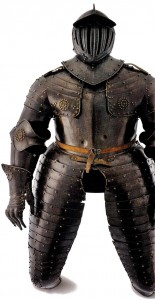
Three-quarter harness. Date around 1630. Origin Germany. Material iron, leather. Height: 185 cm, width 66 cm. Weight: 24.5 kg. At the beginning of the 17th century the heavy cavalry wore this kind of armor reaching to the knee, boots protected the lower leg. The lance had often been abandoned in favor of a sword and a pair of pistols carried in holsters on the saddle. Officers also preferred that armor in field combat.
The Protestants were the first taking offensive. The pike squads advanced down the hill, on their flanks guided by sergeants with halberds. With their long, unwieldy weapons the pikemen intended to attack the enemy infantry by a close “piken thrust”. The cavalry also trotted forward in a dense line, from a distance as short as possible fired a volley from their guns and then withdrew again.

Pike squads and cavallery during the Battle of Breitenfeld, in which Quast participated.
However, Tilly, convinced of the quality of its soldiers, had no intention to remain in the defensive. He ordered his own cavalry and infantry, to proceed up the hill. The Protestant muskets shooters were trained to fire in rolling volleys: The first row fired and stepped back for reloading, while the second row fired etc. Like this, the lengthy loading process of muskets could theoretically be compensated and a permanent fire maintained. But the Catholic pike squares unstoppably marched through the dense powder smoke, their cavalry defeated the Protestant horsemen into flight.
Since without support they could not withstand the collision with the determined pikemen and my cavalry armed with guns from close, the Protestant pike squares quickly broke apart and were beaten, the pikemen ran for their lives. Almost 5,000 men were killed in the battle – a victory for the Catholics won in less than two hours.
King Gustav II. Adolf (1594-1632) of Sweden, called the “Lion from the North”, was an innovative tactician, who highlighted the central role of the cavalry attack on the battlefield. Since 1630 he engaged in the Thirty Years’ War in Germany. Initially victorious, he died in 1632 at the Battle of Lützen.
From Lance to Pistol
In the age of gunpowder the cavalry lost their dominance on the battlefields of Europe. New tactics were needed to reassign to it an important role in conjunction with infantry and artillery.
At the beginning of the 16th century, European armies were still led by knights, who attacked in an elaborate armor with inlaid lance. Traditions like the jousts were at the height of their popularity – 1559 King Henri II. of France was killed by a splintering lance that pierced his visor. On the battlefield, however, the infantry often prevailed, rarely horsemen with lances were able to break open the formations of the pikemen.

Matchlock, 1540, Italy. Weight 3.5 kg. Barrel length 105 cm. caliber 12mm. Henry VIII. ordered 1500 of these muskets in 1544 in the republic of Venice. Some of them were on board his flagship Mary Rose when it sank in the following year. In experiments a modern replica was able to penetrate up to 6 mm steel from almost 30 m distance.
The full plate armor designed to protect against firearms, breast plates were tested by firing bullets at them. But that was not always enough, as is shown in the death of the famous Chevalier de Bayard 1524, whose armor was pierced by an arquebuses bullet. In the following year aristocratic French cavalry was shot to pieces by arquebusiers in the Italian Wars near Pavia. But since the 1550s heavier, bulletproof armor emerged.
A new age
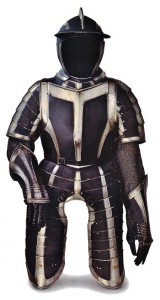
Vassal harness. Date around 1560. Origin Germany. Material: iron, leather. Infantry armors were mass products by the German armorers (Plattner), produced in various designs and qualities according to customers’ requirement. Many were decorated with bare ribbons as here, the remaining surfaces were blackened.
With the rise of the infantry and the obsolescence of the lance new technologies and tactics appeared. Horsemen could not use matchlock weapons, because it required the use of both hands and they needed one hand to direct their horses. However, the self-igniting wheellock enabled the cavalry the use of pistols. In the 1540s mounted German mercenaries introduced firearms and reduced their armor to helmet, cuirass and arm protection. Against the pike squads they developed the Caracole, a maneuver in which the horseman turned his horse to the left and right and fired a pistol on each side. After one row had fired their volley from close range, they withdrew to reload while the next row fired.
At the beginning of the 17th century, the European cavalry had almost completely abandoned the lance, as well as bludgeoning weapons effective against armor, like the war hammer. A cavalryman was equipped with a sword and a firearm, sometimes with several already loaded pistols. Dragoons companies rode on the battlefield, but fought dismounted with firearms just like musketeers. But the commanders were still reluctant to give up the cavalry charge, as it was still considered glamorous and battle decisive.
Under leaders like King Gustav II. Adolf (1594-1632) of Sweden the cavalry regained its shock effect. Positioned at the flanks of the infantry, horsemen first attacked the enemy’s cavalry; after use of their firearms they continued their attack with drawn sword. If the broke through the lines, they could overrun the enemy’s cannons. Musketeer groups further strengthened the mounted firepower, drove the enemy cavalry off the field and thus exposed to the enemy infantry for attack.
Armor and weapons of the cavalry
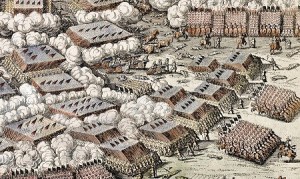
Pike squads and cavallery during the Battle of Breitenfeld, in which Quast participated.
Because of the increasingly used firearms the armors became thicker, by simplification their weight was reduced. The cavalry at the beginning of the 17th century, armed with wheellock pistols and swords, still wore armor reaching down to the knees. For battle against pikemen new tactics emerged, like the Caracole, in which successive rows of horsemen fired their guns and then retreated to reload. At the middle of the century the horsemen, now called arquebusiers because of their weapons, only wore a heavy cuirass and an open helmet over a leather jacket.
Source: Militärgeschichte: Waffen und Kriegführung von der Antike bis heute. Dorling Kindersley, 2013. pp. 114-129.
© 2015 – 2023, Andreas Quast. All rights reserved.
